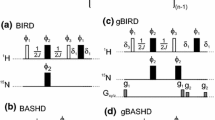Abstract
Joint composite-rotation adiabatic-sweep isotope filters are derived by combining the composite-rotation [Stuart AC et al. (1999) J Am Chem Soc 121: 5346–5347] and adiabatic-sweep [Zwahlen C et al. (1997) J Am Chem Soc 119:6711–6721; Kupče E, Freeman R (1997) J Magn Reson 127:36–48] approaches. The joint isotope filters have improved broadband filtration performance, even for extreme values of the one-bond 1H–13C scalar coupling constants in proteins and RNA molecules. An average Hamiltonian analysis is used to describe evolution of the heteronuclear scalar coupling interaction during the adiabatic sweeps within the isotope filter sequences. The new isotope filter elements permit improved selective detection of NMR resonance signals originating from 1H spins attached to an unlabeled natural abundance component of a complex in which the other components are labeled with 13C and 15N isotopes.










Similar content being viewed by others
References
Bennett AE, Gross JD, Wagner G (2003) Broadband 13C-13C adiabatic mixing in solution optimized for high fields. J Magn Reson 165:59–79
Breeze AL (2000) Isotope-filtered NMR methods for the study of biomolecular structure and interactions. Prog NMR Spectrosc 36:323–372
Böhlen J-M, Burghardt I, Rey M, Bodenhausen G (1990) Frequency-modulated “chirp” pulses for broadband inversion recovery in magnetic resonance. J Magn Reson 90:183–191
Edwards TA, Butterwick JA, Zeng L, Gupta YK, Wang X, Wharton RP, Palmer AG, Aggarwal AK (2006) Solution structure of the Vtsl SAM domain in the presence of RNA. J Mol Biol 356:1065–1072
Evans WAB, Powles JG (1967) Time-dependent Dyson expansion. Nuclear resonance signal in a rotating single crystal. Proc Phys Soc 92:1046–1054
Grzesiek S, Bax A (1993) Amino acid type determination in the sequential assignment procedure of uniformly 13C/15N-enriched proteins. J Biomol NMR 3:185–204
Haeberlen U, Waugh JS (1968) Coherent averaging effects in magnetic resonance. Phys Rev 175:453–467
Hwang TL, Shaka AJ (1995) Water suppression that works. Excitation sculpting using arbitrary waveforms and pulsed field gradients. J Magn Reson Ser A 112:275–279
Kay LE, Keifer P, Saarinen T (1992) Pure absorption gradient enhanced heteronuclear single quantum correlation spectroscopy with improved sensitivity. J Am Chem Soc 114:10663–10665
Khaneja N, Li JS, Kehlet C, Luy B, Glaser SJ (2004) Broadband relaxation-optimized polarization transfer in magnetic resonance. Proc Natl Acad Sci USA 101:14742–14747
Kupče E, Freeman R (1995) Adiabatic pulses for wide-band inversion and broad-band decoupling. J Magn Reson Ser A 115:273–276
Kupče E, Freeman R (1997) Compensation for spin-spin coupling effects during adiabatic pulses. J Magn Reson 127:36–48
Levitt MH (1982) Symmetrical composite pulse sequences for NMR population inversion. I. Compensation of radiofrequency field inhomogeneity. J Magn Reson 48:234–264
Levitt MH (1986) Composite pulses. Prog NMR Spectrosc 18:61–122
Logan TM, Olejniczak ET, Xu RX, Fesik SW (1993) A general method for assigning NMR spectra of denatured proteins using 3D HC(CO)NH-TOCSY triple resonance experiments. J Biomol NMR 3:225–231
Marion D, Ikura M, Tschudin R, Bax A (1989) Rapid recording of 2D NMR spectra without phase cycling. Application to the study of hydrogen exchange in proteins. J Magn Reson 85:393–399
McCoy MA, Mueller L (1993) Selective decoupling. J Magn Reson Ser A 101:122–130
Mitschang L, Rinneberg H (2003) Broadband population inversion by a frequency-swept pulse beyond the adiabatic approximation. J Chem Phys 118:5496–5505
Otting G, Wüthrich K (1990) Heteronuclear filters in two-dimensional [1H, 1H] NMR spectroscopy: combined use with isotope labeling for studies of macromolecular conformation and intermolecular interactions. Q Rev Biophys 23:39–96
Palmer AG, Cavanagh J, Wright PE, Rance M (1991) Sensitivity improvement in proton-detected two-dimensional heteronuclear correlation NMR-spectroscopy. J Magn Reson 93:151–170
Peterson RD, Theimer CA, Wu HH, Feigon J (2004) New applications of 2D filtered/edited NOESY for assignment and structure elucidation of RNA and RNA-protein complexes. J Biomol NMR 28:59–67
Schleucher J, Schwendinger M, Sattler M, Schmidt P, Schedletzky O, Glaser SJ, Sørensen OW, Griesinger C (1994) A general enhancement scheme in heteronuclear multidimensional NMR employing pulsed field gradients. J Biomol NMR 4:301–306
Shaka AJ, Barker PB, Freeman R (1985) Computer-optimized decoupling scheme for wideband applications and low-level operation. J Magn Reson 64:547–552
Stuart AC, Borzilleri KA, Withka JM, Palmer AG (1999) Compensating for variations in 1H-13C scalar coupling constants in isotope-filtered NMR experiments. J Am Chem Soc 121:5346–5347
Tjandra N, Bax A (1997) Direct measurement of distances and angles in biomolecules by NMR in a dilute liquid crystalline medium. Science 278:1111–1114
Zwahlen C, Legault P, Vincent SJF, Greenblatt J, Konrat R, Kay LE (1997) Methods for measurement of intermolecular NOEs by multinuclear NMR spectroscopy: Application to a bacteriophage λ N-peptide/boxB RNA complex. J Am Chem Soc 119:6711–6721
Zwahlen C, Vincent SJF, Kay LE (1998) Analytical description of the effect of adiabatic pulses on IS, I2S, and I3S spin systems. J Magn Reson 130:169–175
Acknowledgements
This work was supported by NIH grants GM50291 (A.G. P.) and GM47021 (D. C.). E.R.V. acknowledges support from a National Science Foundation Graduate Research Fellowship. We thank Joel A. Butterwick (Columbia University), Thomas A. Edwards (Mt. Sinai School of Medicine), and Aneel K. Aggarwal (Mt. Sinai School of Medicine) for the Vts1 SAM domain/TCE 13mer RNA sample. Helpful discussions with Mark Rance (Univ. Cincinnati) are acknowledged gratefully.
Author information
Authors and Affiliations
Corresponding author
Rights and permissions
About this article
Cite this article
Valentine, E.R., Ferrage, F., Massi, F. et al. Joint composite-rotation adiabatic-sweep isotope filtration. J Biomol NMR 38, 11–22 (2007). https://doi.org/10.1007/s10858-006-9131-9
Received:
Revised:
Accepted:
Published:
Issue Date:
DOI: https://doi.org/10.1007/s10858-006-9131-9




